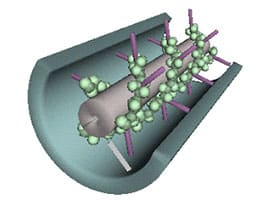 The duct found in a cell wall that allows molecules to pass between the cytoplasms of adjacent cells is called plasmodesm . Plasmodesmata function as intercellular communication pathways.
The duct found in a cell wall that allows molecules to pass between the cytoplasms of adjacent cells is called plasmodesm . Plasmodesmata function as intercellular communication pathways.
A cell is understood to be both the morphological and functional unit that represents the smallest part of any living being. In other words, there is no other smaller element that can be considered alive . The number of cells present in a living being is used to classify it: roughly speaking, we can say that unicellular cells have only one and multicellular cells have two or more.
Another of the concepts mentioned in the first paragraph is that of a molecule , a set of two or more atoms that have a neutral electrical charge and sufficient stability. These must be in a well-defined configuration and be linked by covalent or ionic bonds, both belonging to the strong chemical type. In areas such as biochemistry and organic chemistry, this term can be used synonymously with organic compound .
Although some are branched , most plasmodesmata are straight . They are composed of a plasma membrane , the desmotubule (formed by cisternae of the endoplasmic reticulum) and cytosolic fluid .
The endoplasmic or endoplasmic reticulum is an organelle that is distributed throughout the cytosol of a eukaryotic cell (the liquid found inside). Its main function is to synthesize proteins.
When plasmodesmata develop as part of cell division , they are called primary plasmodesmata . On the other hand, if they appear when the cell wall is already formed, they are called secondary plasmodesmata .
The concept of cell division is of vital importance in the cell cycle , since this is how living beings reproduce and, on a large scale, grow. In the case of unicellular organisms, division occurs through asexual reproduction , while in multicellular organisms tissues develop.
In plant cells , plasmodesmata constitute the most common vehicle for the exchange of substances. This is because they allow the transport of molecules between cells. Thus, proteins , hormones and sugars , for example, can be directed to the phloem through the plasmodesmata.
 Proteins are macromolecules that are made up of amino acids arranged in linear chains. They are synthesized through the action of ribosomes and an mRNA (messenger ribonucleic acid) molecule. Hormones are substances secreted by certain cells that are located in the glands called endocrine glands, which do not have ducts, or in the epithelial glands , which influence the way other cells function.
Proteins are macromolecules that are made up of amino acids arranged in linear chains. They are synthesized through the action of ribosomes and an mRNA (messenger ribonucleic acid) molecule. Hormones are substances secreted by certain cells that are located in the glands called endocrine glands, which do not have ducts, or in the epithelial glands , which influence the way other cells function.
Also mentioned are sugars , carbohydrates that tend to be sweet on the palate. In this group we find monosaccharides, disaccharides and polysaccharides.
Viruses can also circulate through plasmodesmata. Therefore, when faced with an infection, plants can block the plasmodesmata , sending callose to fill the spaces in the ducts.
Let us remember that a virus is an infectious agent that is not made up of cells and can only be observed using a microscope.
It can be said that plasmodesmata function like floodgates. These are channels that regulate and promote communication between plant cells, facilitating the transfer of substances.
Another way to understand plasmodesmata is as bridges that connect cells to each other. Each plasmodesmata is between 50 and 60 nanometers in diameter and is capable of passing through cell walls with a thickness of up to about 90 nanometers . Thanks to the plasmodesmata, larger molecules can overcome the cell wall, which is hard and rigid.
